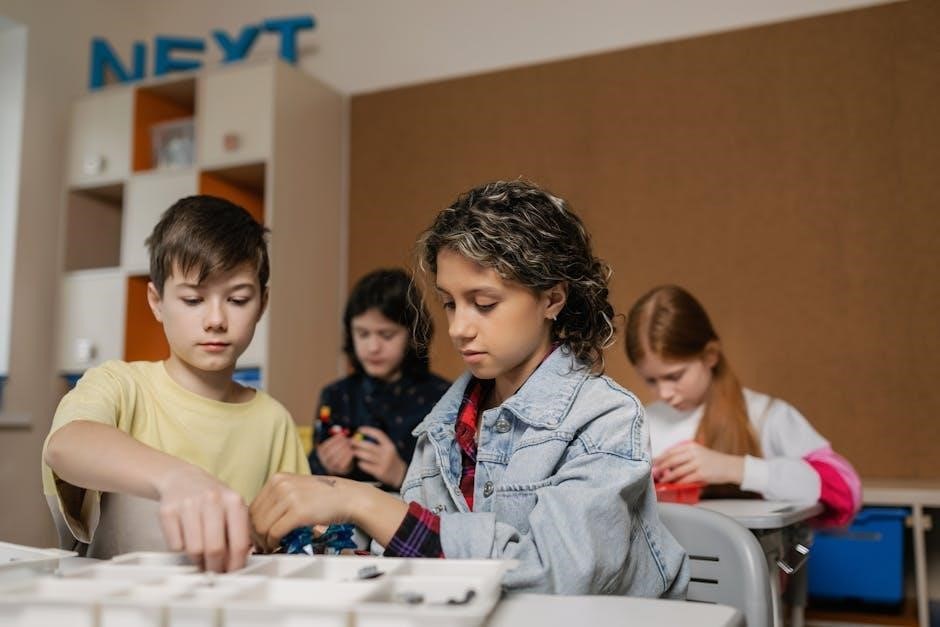Superset workouts are a trendy strength-building method, combining two or more exercises without rest. They enhance efficiency, boost muscle engagement, and are ideal for those seeking intense, time-saving routines.
What Are Superset Workouts?
Superset workouts involve performing two or more exercises consecutively without resting between them. This technique maximizes efficiency by targeting specific muscle groups or improving overall fitness. Supersets can be categorized into types such as same muscle group, opposing muscle group, or compound and isolation exercises. They are designed to increase workout intensity, reduce downtime, and enhance muscle engagement. Typically, a superset consists of completing one set of each exercise in sequence before resting. This approach is popular among fitness enthusiasts seeking to optimize their training time and achieve faster results. Supersets are versatile, suitable for both beginners and advanced lifters, and can be tailored to various fitness goals, making them a cornerstone of modern strength training routines.
Why Superset Workouts Are Popular
Superset workouts have gained immense popularity due to their time efficiency and effectiveness. By combining exercises without rest, they maximize workout intensity, making them ideal for those with limited time. Supersets also enhance muscle engagement and caloric burn, appealing to individuals seeking lean muscle growth and weight loss. Their versatility allows customization to various fitness goals, whether focusing on strength, endurance, or overall fitness. Additionally, supersets reduce downtime between sets, enabling a more dynamic and engaging training experience. This method is particularly favored by fitness enthusiasts who aim to optimize their routines and achieve results quickly. The science-backed approach of supersets further solidifies their reputation as a reliable and efficient training strategy.
Types of Superset Workouts
Superset workouts are categorized into three main types: same muscle group, opposing muscle group, and compound with isolation exercises, each offering unique benefits for targeted training.
Same Muscle Group Supersets
Same muscle group supersets involve performing two or more exercises targeting the same muscle group consecutively without rest. This method maximizes muscle engagement and endurance. For example, pairing incline dumbbell presses with chest-supported dumbbell rows works the chest and back intensely. By focusing on a single muscle group, you can achieve greater fatigue and growth. This approach is ideal for those seeking to improve muscle definition and strength efficiently. It also saves time by eliminating rest periods between exercises. Many fitness enthusiasts prefer this type of superset for its simplicity and effectiveness in isolating specific areas. Incorporating same muscle group supersets into your routine can enhance overall muscle-building results and keep workouts focused.
Opposing Muscle Group Supersets
Opposing muscle group supersets involve pairing exercises that target opposing muscles, such as chest and back or biceps and triceps. This approach allows for balanced development and prevents muscle imbalances. For instance, performing a bench press followed by a row works the chest and back simultaneously. This method is highly efficient, as it engages multiple muscle groups in a single superset. It also enhances overall physique by ensuring proportional growth. Opposing muscle group supersets are particularly effective for full-body workouts, as they promote functional strength and improve joint stability. By alternating between push and pull movements, you can maintain intensity while reducing rest time. This strategy is popular among fitness enthusiasts seeking a well-rounded and time-effective training routine. It also helps in preventing overtraining and keeps workouts dynamic and engaging.
Compound and Isolation Exercise Supersets
Compound and isolation exercise supersets combine multi-joint movements with single-muscle targeting exercises. This pairing enhances workout efficiency by engaging both major and minor muscle groups. For example, pairing a bench press (compound) with dumbbell flyes (isolation) targets the chest from different angles. This approach ensures comprehensive muscle development and prevents weaknesses. Compound exercises build overall strength, while isolation exercises refine muscle shape and definition. Supersetting them allows for a balanced workout, addressing both functional strength and aesthetic goals. This method is ideal for those seeking to maximize time while achieving a well-rounded physique. It also helps maintain muscle balance and promotes progressive overload. By integrating compound and isolation supersets, you can create a versatile routine that supports both performance and appearance. This strategy is widely used in advanced training plans to enhance muscle growth and overall fitness.
Benefits of Superset Workouts
Superset workouts boost efficiency, enhance muscle engagement, and increase caloric burn. They improve endurance and are ideal for those seeking intense, time-saving routines.
Time Efficiency
Superset workouts are renowned for their time efficiency, allowing individuals to maximize their training sessions. By performing two or more exercises back-to-back without rest, supersets significantly reduce overall workout duration. This method is ideal for those with busy schedules, as it enables targeting multiple muscle groups or focusing on specific areas in less time. For example, pairing an incline dumbbell press with a chest-supported dumbbell row works the chest and back efficiently. Supersets also increase workout intensity, making each session more productive. This approach not only saves time but also enhances caloric burn and muscle engagement, making it a popular choice for fitness enthusiasts seeking effective, time-saving routines. Incorporating supersets into a workout plan can help achieve fitness goals faster, even with limited time availability.
Increased Muscle Building
Superset workouts are highly effective for increasing muscle building due to their ability to enhance workout intensity and muscle engagement. By performing exercises back-to-back without rest, supersets prolong the time muscles spend under tension, a key factor for growth. This method also increases metabolic stress, another critical component for muscle hypertrophy. For example, pairing a bench press with an incline dumbbell press targets the chest and shoulders more intensely, stimulating greater muscle development. Additionally, supersets allow for a higher volume of work in less time, which is essential for progressive overload, a fundamental principle of muscle building. The efficiency of supersets makes them a popular choice for those aiming to build lean muscle quickly and effectively; This approach ensures that each workout is optimized for maximum muscle growth, even when time is limited.
Enhanced Caloric Burn
Superset workouts significantly enhance caloric burn by increasing the intensity and efficiency of your training sessions. By performing exercises back-to-back without rest, your heart rate remains elevated, leading to a higher energy expenditure during the workout. This method also engages multiple muscle groups simultaneously, further boosting your metabolic rate. The reduced rest periods between exercises ensure that your body works harder, burning more calories both during and after the workout. Additionally, supersets can increase excess post-exercise oxygen consumption (EPOC), a phenomenon where your body continues to burn calories at an elevated rate following intense exercise. This makes supersets an excellent choice for those looking to maximize caloric burn and support weight loss goals while improving overall fitness. The combination of efficiency and intensity in supersets ensures a calorie-torching workout that delivers results.
Improved Endurance
Superset workouts are highly effective for improving endurance by pushing your body to work continuously with minimal rest. This approach increases cardiovascular stamina and enhances muscular endurance, as your muscles adapt to sustained activity. By performing multiple exercises in quick succession, you train your body to recover faster and handle prolonged exertion. Over time, this leads to improved overall fitness and the ability to tackle longer, more intense workouts. The efficiency of supersets also means you can achieve greater endurance gains in less time, making them ideal for those with busy schedules. Additionally, the constant engagement of muscle groups boosts circulation and lung capacity, further contributing to enhanced endurance levels. Regularly incorporating supersets into your routine can significantly improve your body’s ability to perform both in and out of the gym.
Creating a Superset Workout Routine
Designing a superset routine involves identifying goals, selecting complementary exercises, and structuring sets with minimal rest. Include warm-ups and cool-downs for optimal performance and recovery.
Identifying Your Fitness Goals
Defining clear fitness objectives is crucial for creating an effective superset workout plan. Whether aiming to build muscle, increase endurance, or enhance strength, understanding your goals helps tailor exercises and routines. For instance, those seeking muscle growth may focus on compound movements, while endurance-focused individuals might prioritize higher reps with shorter rest periods. Assessing current fitness levels and setting realistic targets ensures a structured approach. Additionally, aligning goals with lifestyle factors, such as available time and equipment, maximizes adherence and progress. Regularly revisiting and adjusting objectives ensures continued motivation and optimal results. A well-defined plan not only streamlines the workout process but also enhances overall satisfaction and success.
Selecting the Right Exercises
Choosing the right exercises for your superset workout is essential for achieving your fitness goals. Start by identifying muscle groups you want to target, such as chest, back, or legs. Pairing compound movements like bench presses or squats with isolation exercises like bicep curls or tricep dips can maximize efficiency. Consider opposing muscle groups, such as pairing chest exercises with back exercises, to maintain balance and prevent overtraining. For a full-body approach, incorporate exercises that work multiple muscle groups simultaneously, such as deadlifts or clean and presses. Ensure exercises complement each other in terms of equipment and setup to minimize transition time. For example, pairing dumbbell presses with dumbbell rows allows for a seamless superset. Always prioritize exercises that align with your fitness objectives, whether muscle building, endurance, or overall strength. This strategic selection ensures a well-rounded and effective workout routine.
Structuring Sets and Repetitions
Structuring sets and repetitions is crucial for maximizing the effectiveness of superset workouts. Typically, 3-4 sets of 8-12 repetitions are recommended for strength and muscle building, while 12-16 reps are ideal for endurance. For example, pairing incline dumbbell presses with chest-supported rows for 3 sets of 10 reps each allows for balanced development. Rest periods should be minimized, usually 1-2 minutes between supersets, to maintain intensity. Adjusting the rep range and set volume based on your fitness goals ensures progress. For instance, higher reps (12-16) focus on endurance, while lower reps (6-8) emphasize strength. Incorporating compound and isolation exercises in your sets also enhances overall muscle engagement. Proper structuring ensures a balanced and efficient workout, helping you achieve your objectives effectively.
Incorporating Warm-Up and Cool-Down
A proper warm-up and cool-down are essential for optimizing superset workouts. Begin with 5-10 minutes of dynamic stretching, focusing on major muscle groups like shoulders, chest, and legs. Light cardio, such as jogging or cycling, can also prepare your body for intense training. After your workout, static stretches for 20-30 seconds per muscle group help improve flexibility and reduce soreness. Foam rolling or self-myofascial release can enhance recovery by releasing muscle tension. Incorporating these routines ensures better performance, prevents injuries, and aids in muscle recovery. A well-structured warm-up and cool-down routine sets the foundation for a safe and effective superset workout, allowing you to maximize your results and maintain consistency in your training regimen.
Example of a 4-Day Superset Routine
A 4-day superset routine can be structured to target different muscle groups, ensuring balanced development. Day 1 might focus on chest and triceps, with supersets like incline dumbbell press (3 sets of 8-12 reps) paired with chest-supported dumbbell rows (3 sets of 12-16 reps). Day 2 could target back and biceps, featuring exercises like pull-ups (4 sets of 6-8 reps) and dumbbell curls (4 sets of 10-12 reps). Day 3 might emphasize legs, with supersets such as squats (4 sets of 8-10 reps) and Romanian deadlifts (4 sets of 10-12 reps). Day 4 could focus on shoulders and abs, including shoulder presses (3 sets of 8-12 reps) and hanging leg raises (3 sets of 12-15 reps). Each workout should include a 1-minute rest between supersets and 2-3 minutes between exercises. Adjust weights and reps based on fitness levels for optimal results.
Home Workout Superset Example
A home workout superset routine can be effective and equipment-free. Start with push-ups (3 sets of 10-15 reps) paired with bodyweight rows (3 sets of 10-12 reps) using a sturdy chair or bench. Next, combine squats (3 sets of 12-15 reps) with lunges (3 sets of 10-12 reps per leg) to target legs. For core, pair planks (3 sets of 30-60 seconds) with bicycle crunches (3 sets of 15-20 reps per side). Rest for 30-60 seconds between supersets and 1-2 minutes between exercises. This routine builds strength, endurance, and burns calories efficiently. Adjust reps and sets based on fitness levels for a challenging yet achievable workout. Perfect for those with limited time or space, this superset routine delivers results without equipment.
Progressing and Adjusting Your Superset Routine
Gradually increase weight or resistance, vary exercises, and adjust rep ranges to challenge muscles. Manage rest periods and maintain proper form to optimize results and prevent injury.
Increasing Weight or Resistance
Gradually increasing weight or resistance is key to progressing in superset workouts. Start by adding small increments weekly to challenge muscles without overexertion. Focus on maintaining proper form to prevent injury and ensure effective muscle engagement. As strength improves, progressively overload by lifting heavier weights or using resistance bands. Track progress to identify when it’s time to increase intensity. This method not only builds muscle but also enhances overall strength and endurance. For example, in a bench press superset, increase the dumbbell weight once 12 reps become manageable. Similarly, in rows, elevate resistance to continue stimulating growth. Consistency and patience are crucial for sustainable gains. Always prioritize technique to maximize results and avoid plateaus.
Varying Exercises and Rep Ranges
Varying exercises and rep ranges is essential for continuous progress in superset workouts. Switching exercises prevents plateaus by targeting muscles from different angles, ensuring balanced development. For example, alternate between bench presses and incline dumbbell presses to vary chest workouts. Similarly, swap rows with lat pulldowns to target the back differently. Adjusting rep ranges also keeps routines fresh; use lower reps (4-6) for strength-focused exercises and higher reps (12-15) for endurance and muscle endurance. This variation challenges muscles and prevents overadaptation. Incorporate compound exercises like squats and deadlifts for full-body engagement, then pair them with isolation exercises like bicep curls or tricep dips for targeted growth. Regularly updating your exercise selection and rep schemes ensures a dynamic, effective workout that avoids stagnation and keeps you motivated. This approach also helps maintain long-term muscle engagement and overall fitness progression.
Managing Rest Periods
Managing rest periods is crucial for optimizing superset workouts. Rest durations between supersets vary based on fitness goals, typically ranging from 60 to 90 seconds. This allows partial recovery, maintaining intensity while preventing excessive fatigue. For endurance-focused routines, shorter rest periods (30-60 seconds) are ideal, while strength-based workouts may require longer rests (90-120 seconds) to recover fully. Consistency in rest timing ensures workouts remain structured and effective. Use a timer to track intervals and stay disciplined. Additionally, active recovery during rest, such as light stretching or deep breathing, can enhance overall performance. Properly managing rest periods balances recovery and intensity, maximizing the benefits of supersets. This approach ensures sustained energy levels and prevents overtraining, making it a key component of successful superset routines. By tailoring rest periods to your goals, you can achieve a more efficient and productive workout.
Maintaining Proper Form
Maintaining proper form is essential for maximizing the effectiveness of superset workouts while minimizing injury risk. Focus on controlled movements and full range of motion to target muscles effectively. Avoid sacrificing form for heavier weights or faster reps, as this can lead to poor technique and potential harm. For example, during a bench press, ensure your chest is engaged, and the weight is lowered slowly. Similarly, in squats, keep your back straight and knees aligned with toes. Start with lighter weights to master the movement pattern before increasing intensity. Use mirrors or a trainer for feedback to correct any imbalances. Proper form ensures that each exercise is performed safely and efficiently, allowing you to reap the full benefits of your superset routine. Consistency in maintaining good form will enhance your progress and overall workout experience.
Superset workouts offer a powerful and efficient way to enhance strength, build muscle, and boost endurance. By combining exercises strategically, supersets save time while maximizing results. Whether focusing on same muscle groups, opposing muscles, or blending compound and isolation exercises, supersets cater to diverse fitness goals. Their adaptability makes them suitable for both beginners and advanced trainees, allowing for easy adjustments in weight, reps, and rest periods. To ensure safety and effectiveness, maintaining proper form is crucial. Consistency and gradual progression are key to achieving long-term success. Incorporating supersets into your routine can elevate your workouts, helping you reach new levels of fitness efficiently. With their versatility and proven benefits, supersets are a valuable addition to any training plan, making them a timeless choice for those seeking impactful results.















































































